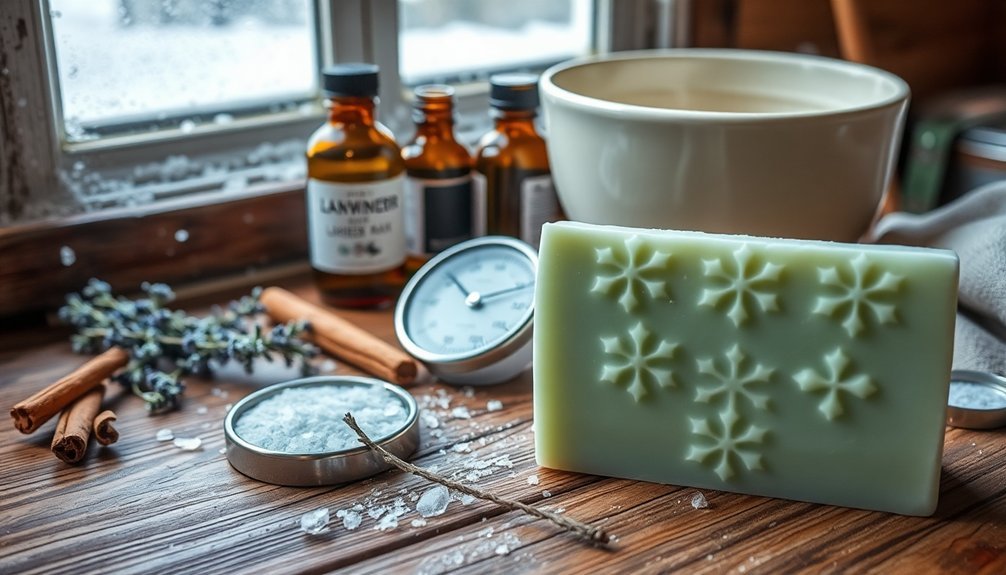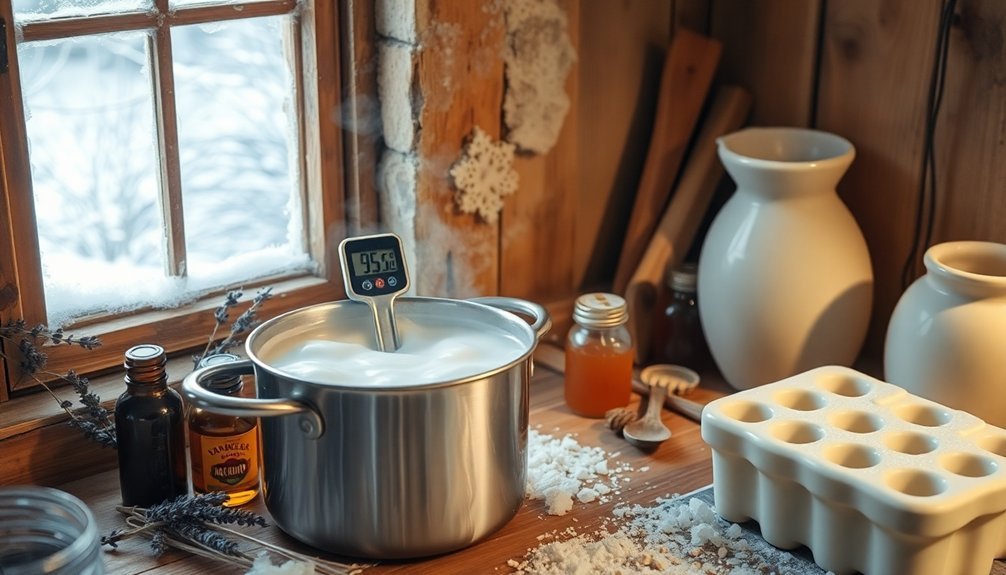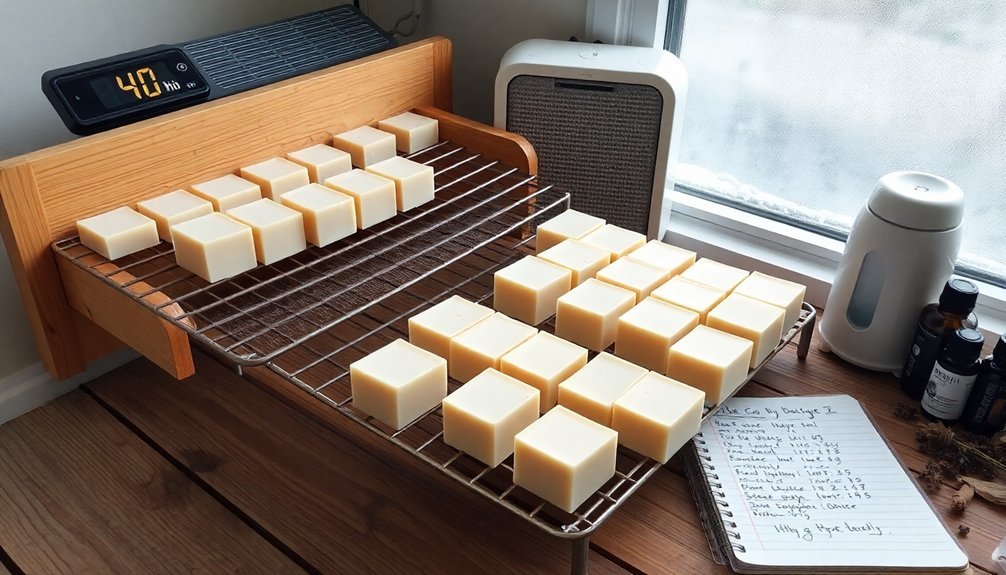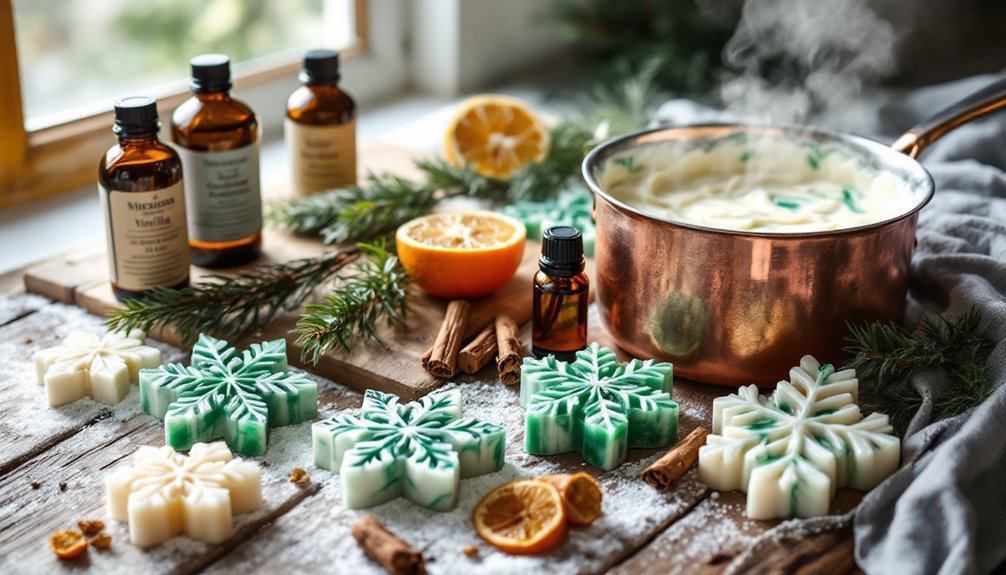When making soap in winter, you'll need to adjust your techniques for better results. Increase hard oils by 5-10%, maintain higher temperatures (100-110°F) to prevent false trace, and insulate molds thoroughly. Consider using fresh snow instead of water for a unique touch. Pre-melt solid oils like coconut before mixing, use winter botanicals for seasonal appeal, and create a dedicated curing space with controlled humidity. These adjustments will transform your winter soap-making experience.
7 Winter Soap Making Tips for Better Results

When winter's chill sets in, soap making offers unique opportunities and challenges for crafters. You can actually use fresh snow instead of water in your lye solution, as it provides consistent weight when melted and dissolves lye efficiently.
Room temperature typically suffices for mixing your oils and lye during winter months—precise temperature control isn't as critical as you might think.
Wear protective gear including gloves, goggles, and long sleeves when handling lye, and make certain your workspace is well-ventilated to avoid inhaling fumes.
Embrace winter-inspired designs by incorporating blues and whites for snowflake motifs or winter landscapes. For a dramatic blue color, try adding indigo powder to a portion of your soap batter as a natural colorant option. Add sparkle with micas for a festive look.
Consider winter-themed fragrances like peppermint to enhance the seasonal experience, adding them at the "trace" stage of your process.
Adjusting Oil Ratios for Cold Weather Conditions
Cold weather soap making requires strategic oil ratio adjustments to guarantee your bars remain firm yet moisturizing.
Winter formulations need more hard oils and carefully balanced fatty acids to perform well during colder months.
- Increase your hard oils (coconut and palm) to 40-45% of your total recipe—this creates a firmer bar that won't soften in cold conditions while maintaining good lather properties.
- Reduce soft oils like olive oil and substitute with alternatives like peanut or canola oil for better stability.
- Add 5-10% castor oil to support lather stability and overall bar performance in cold temperatures.
- Incorporate moisturizing butters like shea (up to 15%) to combat winter dryness without compromising bar hardness.
Consider using babassu oil as it can effectively replace coconut oil while still providing quick absorption properties beneficial for winter soap formulations.
Mastering Temperature Control in Winter Soap Making

During winter months, temperature control becomes the most vital factor in successful soap making, as the colder ambient conditions can dramatically affect your entire process.
You'll need to pre-melt coconut oil, which solidifies below 76°F, and maintain oils between 120-130°F to guarantee proper incorporation.
Watch for false trace—a common winter issue where oils solidify before fully reacting with lye. Using digital thermometers provides precise readings essential for cold-weather soaping.
Consider implementing heat transfer methods or using a heating pad set to medium underneath your workspace. The ideal range of 120-130°F ensures that all hard oils and butters remain completely melted throughout the soap making process.
Proper insulation becomes essential in winter. Cover your molds with towels or blankets to maintain the gel phase, which enhances color vibrancy and texture.
If working in a particularly cold space, you might need additional insulation methods to achieve the best results.
Incorporating Seasonal Botanicals for Skin Nourishment
Winter's botanical bounty offers exceptional ingredients for your cold-weather soap creations.
You'll find dried herbs like calendula provide a saving grace for parched skin, while evergreen needles infuse soaps with both forest-fresh scent and surprising skin benefits.
Incorporating these seasonal elements won't just enhance your soap's visual appeal—they'll transform your daily cleansing routine into a truly nourishing experience. Pine needles, which can be used to create both infused olive oil and tea for your soap base, add a distinctive winter essence perfect for holiday gifting.
Dried Herbs for Winter
The natural bounty of dried herbs offers exceptional benefits for soap making as temperatures drop and skin needs extra nourishment. Incorporating these botanical elements can transform a simple soap into a therapeutic winter skin remedy.
- Lavender and rosemary combine antibacterial properties with soothing scents—add them at trace in cold process soap or infuse in oils beforehand for consistent benefits.
- Calendula and chamomile provide healing and anti-inflammatory effects perfect for winter-irritated skin while adding natural color.
- Grinding herbs into fine powders guarantees even distribution throughout your soap without scratchy textures. Using an indoor herb garden can provide fresh ingredients year-round for your soap making projects.
- Herbal infusions can replace water in your recipes—try mint tea for an invigorating soap that calms irritated skin while fighting acne.
Evergreen Needle Benefits
Incorporating evergreen needles into your winter soap recipes combines aromatic delight with exceptional skin benefits. Pine, spruce, and fir needles infuse your soaps with fresh forest scents while delivering antioxidants that protect skin from harsh winter elements.
You'll find these seasonal botanicals particularly effective for healing dry, cracked skin thanks to their natural anti-inflammatory properties. When you infuse evergreen needles in carrier oils like olive or coconut, you're creating a base that soothes troubled skin conditions including eczema and acne. Among the many options, White, Red, and Jack pines from the US mid-western region offer excellent aromatic qualities for soap making.
For best results, you can use fresh needles to preserve aromatherapy benefits or dried ones for convenience. Consider complementing these conifer scents with cinnamon leaf essential oil for aromatic complexity.
Remember that these moisturizing soaps typically require longer curing times to reach their full potential.
Calendula Saving Grace
While evergreens offer winter protection, calendula flowers deliver unparalleled skin nourishment during harsh weather months.
These golden blooms retain their vibrant color and healing properties even when incorporated into your cold process soaps, making them perfect for winter skincare formulations. Orange varieties like Indian Prince produce the most vibrant colors when infused into oils for soap making.
- Infuse olive oil with dried calendula petals for two weeks to create a natural yellow colorant that adds moisturizing benefits to your winter soap recipes.
- Combine calendula with goat milk for enhanced skin-soothing properties that combat dryness and flaking common in colder seasons.
- Use calendula tea instead of distilled water in your lye solution to intensify the natural coloring and potential skin benefits.
- Add dried petals to the soap's surface for visual appeal, or incorporate them throughout for gentle exfoliation.
Preventing False Trace During Cold Weather Batching
During winter's chill, your soap oils will cool rapidly and potentially solidify, causing deceptive false trace before proper saponification occurs.
You'll need to maintain oil temperatures around 100-110°F throughout your batching process, particularly when working with coconut oil and butters that solidify quickly at room temperature.
Selecting recipes with higher percentages of liquid oils can give you more working time and help prevent the frustrating graininess that accompanies false trace in cold conditions. Checking for a grainy appearance in your soap batter can alert you to false trace before it becomes problematic.
Recognizing Temperature Impact
As winter arrives, soap makers face unique challenges with temperature management that can make or break a batch. The colder ambient conditions can greatly affect your soap's trace development and final quality.
- Monitor your workspace temperature – rooms below 65°F can cause oils to solidify prematurely, leading to false trace before proper saponification occurs.
- Aim for higher initial temperatures (100-110°F) when mixing oils and lye during winter compared to your summer batches.
- Keep an eye on high-melting oils like coconut and palm, ensuring they remain fully melted and clear before adding lye solution. This is especially important for oils like cocoa butter with a melting point of 93°F, which solidifies quickly in cold environments.
- Consider insulating your molds more thoroughly in winter to promote proper gel phase, which can enhance color vibrancy and reduce soda ash formation.
Proper Oil Selection
Selecting the right oils for your winter soap formulations becomes crucial when temperatures drop and false trace threatens your batches. Incorporate more liquid oils like olive or apricot kernel to maintain a workable consistency during cold weather soap making.
Balance your formula by adjusting the ratio of hard to soft oils—reduce coconut and palm oil percentages while increasing liquid oils to prevent premature solidification. This adjustment helps avoid false trace while still maintaining the soap's quality.
For winter soaps that perform well, combine moisturizing oils like avocado and castor with hardening oils like palm. Consider adding rice bran oil for its moderate shelf life and ability to produce smooth texture in cold temperatures.
Don't forget to stir your mixture longer to guarantee complete ingredient incorporation. These strategies will help you create successful winter soap batches with consistent textures and reliable trace development.
Optimizing Curing Environments for Winter Months

When temperatures drop and humidity levels fluctuate, creating the ideal curing environment for your handmade soaps becomes particularly challenging.
Winter conditions can greatly extend curing times, potentially affecting your soap's quality and production schedule.
- Control humidity by using dehumidifiers in your curing space, especially in basements where moisture tends to accumulate.
- Ensure proper air circulation with strategically placed fans that promote even moisture evaporation without creating drafts.
- Consider alternative spaces like attics or well-ventilated garages that maintain consistent temperatures while providing better airflow.
- Design your soap racks to maximize airflow around each bar, elevating them on mesh surfaces rather than solid platforms.
The curing process, which is essential for water evaporation and not the same as saponification, typically requires 4-6 weeks for optimal soap performance.
Don't forget to monitor your soaps regularly for soft spots, which indicate incomplete curing.
Utilizing Snow as a Unique Soap Making Ingredient
The magical properties of snow extend far beyond creating winter wonderlands—it can transform your cold process soap recipes into unique seasonal creations. Fresh, untouched snow serves as a perfect substitute for water, melting to an equivalent volume when combined with lye. For optimal results, avoid yellow snow that might introduce impurities into your soap batch.
| Snow Soap Benefits | Considerations | Comparison to Water |
|---|---|---|
| Creates visually appealing white bars | Seasonal availability only | Functionally equivalent |
| Adds winter nostalgia to your craft | Requires same safety precautions | May affect saponification slightly |
| Works with most existing recipes | Best results with light-colored oils | Similar lather and texture |
When collecting snow, choose pristine patches away from contaminants. The cold temperature naturally helps the lye dissolve without scorching, resulting in a consistently smooth mixture. You'll enjoy both the novelty of the process and the unique winter-themed soap it produces.
Frequently Asked Questions
How Do Fragrance Oils Perform Differently in Winter Soap Recipes?
You'll find fragrance oils maintain their scent better in winter soap recipes, blend more easily in cooler temperatures, and aren't as prone to accelerating trace as essential oils. They're stronger, longer-lasting, and more stable.
Can I Substitute Synthetic Colorants With Natural Winter Ingredients?
Yes, you can substitute synthetic colorants with natural ingredients like alkanet root, annatto seeds, burdock leaf, or spirulina. They'll provide unique colors but may offer less consistency and require oil infusion before use.
Does Altitude Affect Winter Soap Making and Curing Times?
Yes, altitude affects your soap making and curing. You'll notice faster drying at higher elevations due to lower humidity, while temperature differences may impact saponification. You'll need to monitor and adjust your process accordingly.
How to Troubleshoot Glycerin Rivers in Winter Soap Designs?
You'll need to lower water content, decrease temperatures, and guarantee even cooling to combat glycerin rivers. Try adding titanium dioxide gradually, avoiding overheating, and reducing insulation around molds during winter soapmaking.
What Equipment Modifications Are Needed for Cold-Temperature Soap Making?
You'll need insulated containers for lye and oils, a reliable thermometer for precise temperature readings, heating pads to maintain warmth, and draft shields around your workspace. Consider pre-warming your molds as well.
In Summary
When you apply these seven winter soap making adjustments, you'll create beautiful, high-quality soaps despite the season's challenges. Remember to monitor temperatures, adjust your oils, and create proper curing conditions. Don't hesitate to experiment with seasonal ingredients like snow and winter botanicals. Your cold-weather soaps will not only perform better, they'll capture the essence of winter while keeping your skin protected during the harshest months.





Leave a Reply